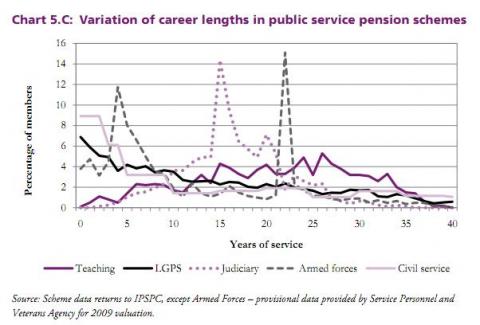Does the average civil servant sit on a pension pot worth half a million pounds?
"A civil servant on a median salary — the middle salary — of £23,000 will receive after a career of 40 years (which many will have) a pension pot worth £500,000." Francis Maude, Radio 4 Today, 15 June 2011
With the Public and Commercial Services (PCS) Union yesterday voting in favour of strike action over plans to reduce jobs, pay and pension provisions, the 'perks' given to public sector workers again found themselves in the limelight.
Cabinet Office Minister Francis Maude took to the airwaves to defend his Government's pension reforms, telling Radio 4's Today programme that some civil servants could be sitting on "pension pots" of half a million pounds.
But just how representative this is of civil servant pensions has been a hotly disputed matter. General Secretary of the PCS union Mark Serwotka hit back, arguing that the example used by Mr Maude was unrealistic because his hypothetical pensioner would have to live to 105 years old to claim the full £500,000
Join 72,953 people who trust us to check the facts
Sign up to get weekly updates on politics, immigration, health and more.
Subscribe to weekly email newsletters from Full Fact for updates on politics, immigration, health and more. Our fact checks are free to read but not to produce, so you will also get occasional emails about fundraising and other ways you can help. You can unsubscribe at any time. For more information about how we use your data see our Privacy Policy.
Having previously refereed disputes on the size of the 'average' public sector pension, Full Fact went in search of the details behind this particular debate.
Pension pots of half a million pounds?
According to Lord Hutton's review of public sector pensions, employees are required to contribute either 1.5 per cent or 3.5 per cent of their earnings to the civil service pension scheme. In return, the employer contributes an average of 19 per cent of the employee's salary into their pension pot.
If we use the higher level of employee contributions, this would mean that a civil servant on £23,000 would put aside £805 per year towards their retirement, with the employer adding £4,370, giving a total annual contribution of £5,179. If their salary did not rise, to accrue a £500,000 "pension pot", they would therefore have to work fo nearly a century to reach the level set by Francis Maude (although median salaries could be expected to rise with inflation under normal circumstances).
However the civil service pension scheme is based on the defined benefit model, which means that employees work towards a defined annuity to be received on retirement, the size of which is defined by the employees salary, rather than by accruing a "pension pot" based on the amount contributed directly to the scheme. Mr Maude's reference to a "pension pot" is therefore a bit of a red herring.
The civil service scheme works by increasing the amount an employee is entitled to by one eightieth of their salary for every year worked, from which the worker can claim an annuity at a set rate. The Financial Services Authority suggests that this annuity rate would be around 2.9 per cent.
Using our example therefore, a civil servant on £23,000 over 40 years would be due an annual pension of £11,500 (23,000x40x1/80th). To purchase an annuity of this value would therefore require £396,552 (11,500/0.029).
On top of this, civil servants receive a lump sum to the value of three times their pension on retirement. Once this is added in to the equation, we end with a final value of £431,052, a little short of Mr Maude's total, but within touching distance.
How many civil servants really spend 40 years in the job?
Mr Maude's claim that "many" civil servant retire after a career of 40 years may however need some context.
The PCS argues that 40 years is an exceptional length of service, claiming instead that the average amount of time a civil servant spends in the job is eight years.
According to the Hutton review, the average length of service in the civil service was 13 years. As the graph below demonstrates, the review also found that fewer than two per cent of civil servants stay in their job for 40 years, although more do so than in other areas of the public sector.

To illustrate this point, we can see from 2006 research by the Taxpayers' Alliance that only 100 civil servants were thought to have pension pots today worth over £500,000, a small proportion of the total workforce in jobs at the upper end of the salary scale.
Conclusion
While Francis Maude's claim that average civil servants could be looking at pension pots of half a million pounds might at first seem to be at odds with the protestations made by Mark Serwotka that the average civil service pension is only £4,200 per year, both can be substantiated.
Just as the PCS figure for the average pension can be reached by taking the suggestion of the interim Hutton report - £5,023 — and removing the impact of high-earning "outliers", Mr Maude's total for a median pension pot can be more or less arrived at by calculating the benefits due to an employee with a fairly exceptional term of service: 40 years.
According to Lord Hutton, this set of circumstances applies to less than 2 per cent of civil servants, while the Taxpayers' Alliance figures from 2006 suggested that the majority of those civil servants currently sitting on pension pots of half a million pounds were in the very highest salary bands. Questions about how representative Mr Maude's example is of the pensions accrued by most civil servants do therefore seem to have some legitimacy.
Thanks to Christie Malry over at the FCA Blog for his help with this article